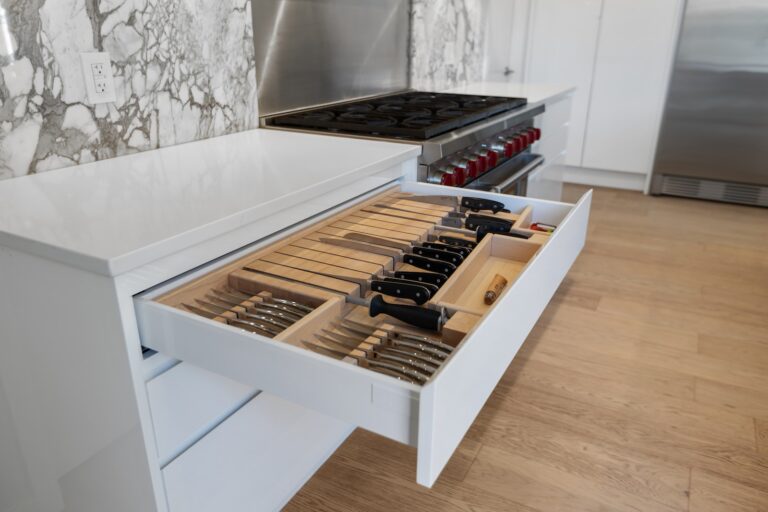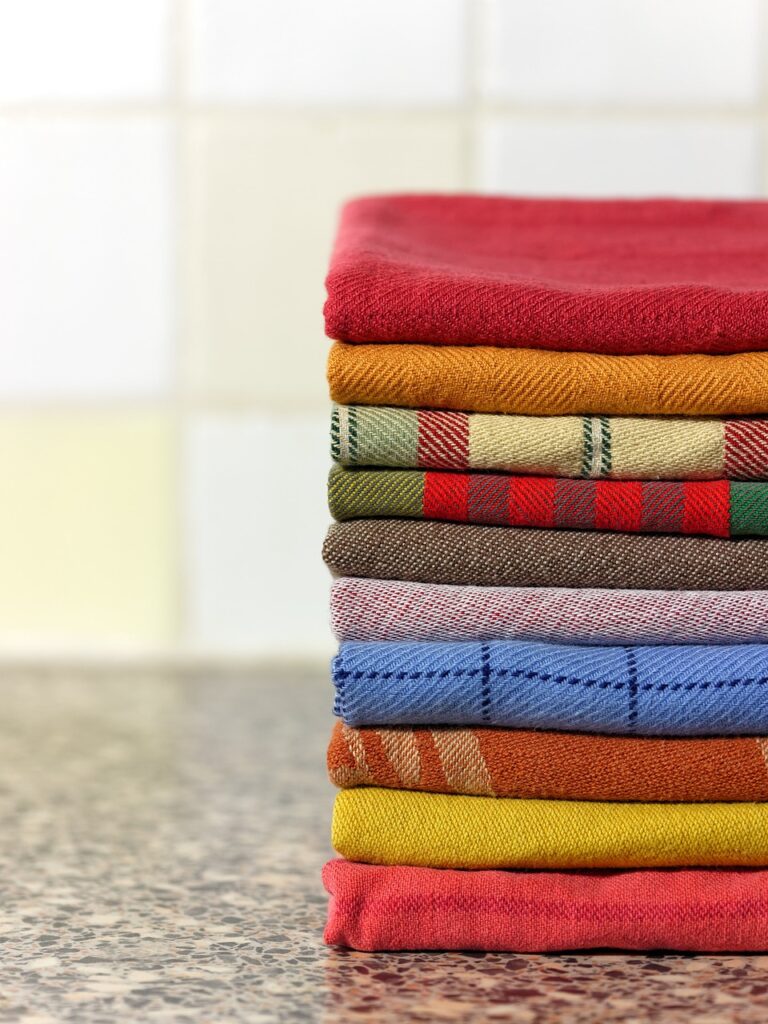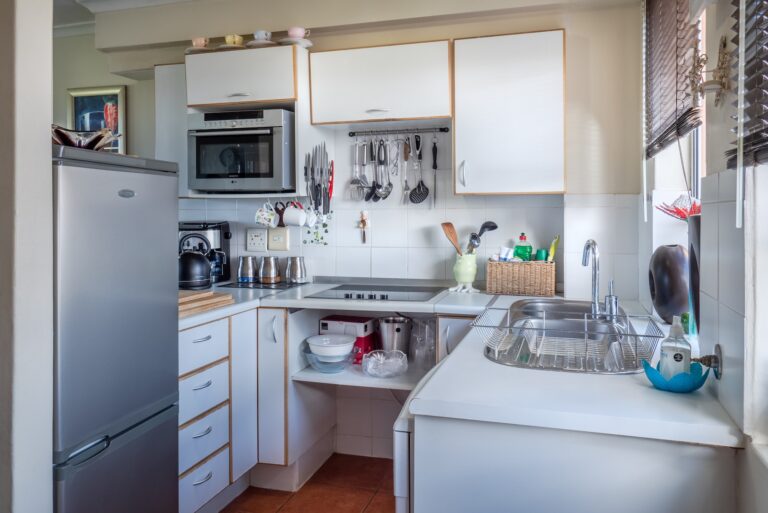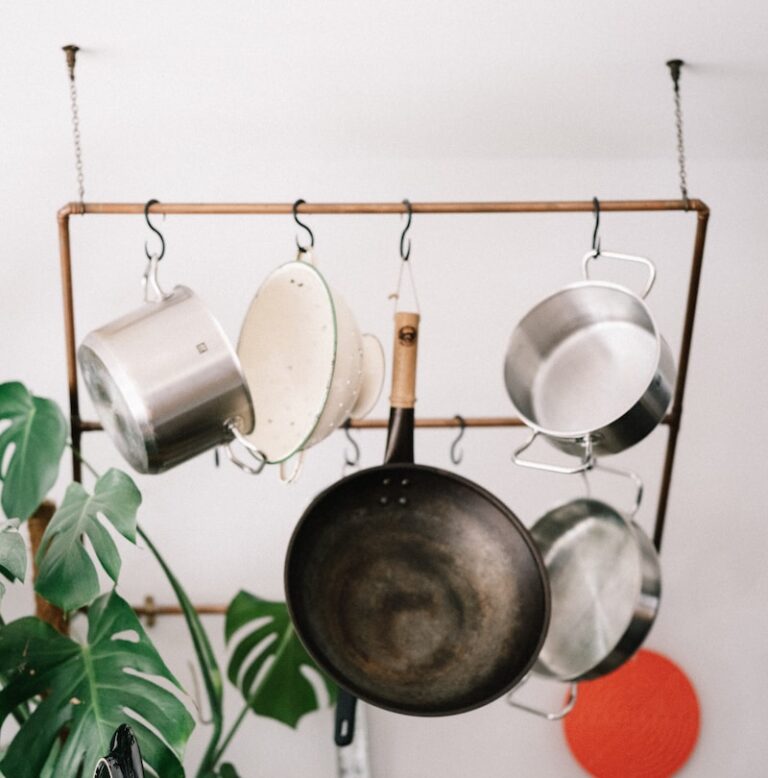Hey there! In this article, I’ll be sharing some expert advice on how to clean and maintain your kitchen cabinets.
I’ll walk you through the different types of cabinets, the essential tools you’ll need, and a step-by-step guide to get them sparkling clean.
We’ll also tackle stubborn stains, replacing hardware, and organizing your cabinets for maximum efficiency. Plus, I’ll share some tips on protecting your cabinets from water damage.
Let’s get started!
Key Takeaways
- Different types of kitchen cabinets offer various benefits, such as durability, cost-effectiveness, and modern aesthetics.
- Essential tools and supplies for cleaning and maintenance include microfiber cloths, gentle cleaners, wood polish or oil, and felt pads for protection.
- It is important to consider the cost comparison of different cabinet materials, as they can significantly impact the overall kitchen renovation budget.
- Regular cleaning, using preventative measures, and proper organization and storage are essential for long-term cabinet maintenance.
Understanding the Different Types of Kitchen Cabinets
I’m currently learning about the different types of kitchen cabinets, and I’m amazed at how many options there are! When it comes to kitchen cabinets, there’s a wide range of materials to choose from.
You can opt for solid wood cabinets, which are known for their durability and timeless appeal. Alternatively, there are laminate cabinets, which are more cost-effective and come in various colors and patterns.
Another option is thermofoil cabinets, which are made of a vinyl material that’s wrapped around a fiberboard. These cabinets offer a sleek and modern look at a lower cost.
It’s important to consider the cost comparison when choosing the material for your cabinets, as it can significantly impact your overall kitchen renovation budget.
Essential Tools and Supplies for Cleaning and Maintenance
I’ve found that having the right tools and supplies makes all the difference when it comes to cleaning and maintaining my kitchen cabinets.
Some must-have cleaning tools include:
- Microfiber cloths
- A soft-bristle brush
- A gentle cleaner
For maintenance, I highly recommend having:
- A good quality wood polish or oil
- Felt pads to protect the cabinet surfaces from scratches.
Must-Have Cleaning Tools
I always keep a microfiber cloth handy, as it’s a must-have tool for effective cleaning. It’s amazing how much dirt and grime it can pick up with just a little water.
But besides the microfiber cloth, there are a few other must-have cleaning tools that I rely on:
- All-purpose cleaner: This versatile product is essential for tackling various surfaces and stains. From countertops to appliances, it helps me achieve a deep clean without damaging the surfaces.
- Scrub brush: Sometimes, a cloth alone isn’t enough to remove tough stains or grime. That’s when a scrub brush comes to the rescue. It’s great for scrubbing away stubborn dirt and reaching into tight corners.
- Vacuum cleaner: Keeping floors clean is just as important as surfaces. A vacuum cleaner with attachments helps me easily remove dust, debris, and pet hair from carpets, rugs, and hard floors.
Recommended Maintenance Supplies
Having the right maintenance supplies, such as a set of screwdrivers and a can of lubricant, is crucial in keeping my home appliances in optimal condition.
But when it comes to cleaning and maintaining my appliances, I also want to make sure I’m using the recommended cleaning products. These products not only ensure effective cleaning but also help to extend the lifespan of my appliances.
Lately, I’ve been exploring eco-friendly alternatives for cleaning and maintenance. These products aren’t only better for the environment but also safer for my family and pets.
I’ve found that using natural ingredients like vinegar and baking soda can be just as effective as traditional cleaning products. Plus, they’re affordable and easily accessible.
Taking care of my appliances with the right cleaning products and eco-friendly alternatives is a win-win for both my home and the environment.
Preparing Your Cabinets for Cleaning
Before starting the cleaning process, I always take off all the dishes and wipe down the surfaces of my cabinets to get rid of any dust or debris. It’s important to have a clean surface before applying any cleaning products or repainting cabinets.
Here are three alternative cleaning methods I use for maintaining my kitchen cabinets:
- Vinegar and water solution: Mixing equal parts of vinegar and water creates a natural cleaning solution that effectively removes grease and grime from cabinet surfaces.
- Baking soda paste: A mixture of baking soda and water forms a paste that can be used to gently scrub away tough stains and residue on cabinets.
- Lemon juice: Lemon juice is a great natural cleaner that can be used to remove sticky residue or add a fresh scent to cabinets. Just apply lemon juice to a cloth and wipe down the surfaces.
With these alternative cleaning methods, I can keep my cabinets looking fresh and clean without harsh chemicals.
Step-by-Step Guide to Cleaning Kitchen Cabinets
I find that following a step-by-step guide to cleaning kitchen cabinets makes the process much easier and more efficient. Understanding cabinet materials and using proper cleaning techniques are essential for maintaining the beauty and functionality of your cabinets. To help you with this task, I have prepared a simple guide below:
| Step | Task |
|---|---|
| 1 | Empty the cabinets and remove all items |
| 2 | Dust the cabinets with a microfiber cloth |
| 3 | Mix a solution of warm water and mild dish soap |
| 4 | Gently scrub the cabinet surfaces with a soft cloth or sponge |
Deep Cleaning Techniques for Stubborn Stains and Grease
I’ve tried various deep cleaning techniques to tackle stubborn stains and grease on my kitchen cabinets.
One effective method is using a mixture of baking soda and warm water to create a paste, which I then apply to the problem areas and let sit for a few minutes before scrubbing with a sponge.
Another option is using a vinegar and water solution to break down the grease, followed by wiping with a microfiber cloth.
These techniques have proven successful in removing tough stains and grease buildup, leaving my cabinets looking clean and refreshed.
Tough Grease Removal
Removing tough grease from kitchen cabinets can be a challenging task, but with the right techniques and cleaning products, it becomes much easier. Here are three effective methods I’ve found to tackle tough grease buildup and keep your cabinets looking clean and shiny:
- Vinegar and water solution:
Mix equal parts white vinegar and water in a spray bottle. Spray the solution onto the grease stains and let it sit for a few minutes. Then, scrub the area with a sponge or soft cloth. Vinegar is a natural degreaser and will help break down the tough grease.
- Baking soda paste:
Make a paste using baking soda and water. Apply the paste to the grease stains and let it sit for a while. Then, scrub the area with a brush or sponge. Baking soda acts as a gentle abrasive and helps lift away the grease.
- Lemon juice and salt:
Cut a lemon in half and dip it into some salt. Use the lemon halves to scrub the grease stains on your cabinets. Lemon juice is a natural cleaner and the salt adds some abrasiveness to help remove the grease.
Stain Removal Methods
Using a mixture of hydrogen peroxide and dish soap, you can effectively remove stubborn stains and grease from various surfaces. It’s a simple and affordable DIY stain remover that works like magic. I have personally tried this technique on my kitchen countertops and it worked wonders. The hydrogen peroxide acts as a bleaching agent, while the dish soap helps to break down the grease and grime. Here’s a table to give you a better idea of how this stain removal technique works:
| Ingredient | Purpose | Effectiveness |
|---|---|---|
| Hydrogen Peroxide | Bleaching Agent | High |
| Dish Soap | Grease Breakdown | Moderate |
| Warm Water | Dilution | High |
With these stain removal techniques, you don’t have to worry about those stubborn stains ruining the appearance of your surfaces anymore. Give it a try and see the difference it makes!
Preventative Measures for Long-Term Cabinet Maintenance
I’ll share some simple tips to keep my kitchen cabinets in great condition for the long-term.
- Use soft cloths or microfiber towels when cleaning the cabinets to prevent scratches. Avoid abrasive sponges or harsh cleaning solutions that can damage the surface.
- Regularly wipe down the cabinets to remove any spills or stains that may cause moisture buildup. Moisture can lead to warping or discoloration of the wood.
- Install cabinet liners to provide an extra layer of protection against moisture. These liners can also help to keep the cabinets clean by catching any drips or spills before they reach the surface.
How to Remove and Replace Cabinet Hardware
So, you want to know how to remove and replace your cabinet hardware? Well, it’s actually quite simple.
Start by unscrewing the old hardware using a screwdriver, then measure the hole spacing to ensure you get the right size replacements.
Finally, attach the new hardware by aligning the holes and tightening the screws.
It’s a quick and easy way to update the look of your cabinets!
Best Cabinet Hardware Options
I love exploring the variety of options for cabinet hardware and finding the perfect one to enhance the look of my kitchen. When it comes to cabinet hardware finishes, there are so many choices available that can really make a statement in your space.
Here are three options that I find particularly appealing:
- Brushed Nickel: This finish offers a sleek and modern look, perfect for contemporary kitchens.
- Antique Brass: If you’re going for a more traditional or vintage vibe, this finish adds a touch of elegance and warmth.
- Matte Black: For a bold and dramatic look, matte black hardware can add a striking contrast to light-colored cabinets.
Choosing the right cabinet knobs is crucial to achieving the desired aesthetic in your kitchen. Whether you prefer a polished and refined look or a more rustic and eclectic feel, exploring the different finishes and styles available is the key to finding the perfect cabinet hardware for your space.
Tips for Easy Replacement
Removing and replacing cabinet hardware is a simple task that can easily update the look of your kitchen. With easy installation and quick replacement, you can transform your cabinets in no time. Whether you’re looking to upgrade the style or functionality of your hardware, there are plenty of options to choose from.
Here is a table showcasing some popular cabinet hardware options:
| Hardware Type | Material |
|---|---|
| Knobs | Brass |
| Pulls | Stainless Steel |
| Handles | Chrome |
| Hinges | Nickel |
| Drawer Slides | Zinc Alloy |
Tips for Organizing and Decluttering Your Cabinets
While organizing and decluttering my cabinets, I found that using clear storage containers helped maximize space and keep items easily visible. Here are three tips for maximizing storage space and best practices for organizing spices:
- Invest in clear storage containers: Clear containers allow you to easily see what’s inside, making it easier to find what you need without rummaging through stacks of boxes or bags.
- Categorize and label: Sort your spices into categories such as baking, cooking, and herbs. Label each container accordingly to make it even easier to locate the specific spice you need.
- Utilize vertical space: Make use of vertical space by using shelf organizers or stacking containers. This allows you to store more items while still keeping everything accessible.
Protecting Your Cabinets From Water Damage
To prevent water damage to your cabinets, regularly check for leaks under the sink and promptly address any issues that arise. Water can be extremely damaging to cabinets, causing warping, discoloration, and even mold growth. By taking proactive measures, you can protect your cabinets and prolong their lifespan. One important step is to inspect the area under the sink for any signs of leaks, such as water stains or dripping water. If you notice any issues, it is crucial to address them immediately. Additionally, it is recommended to use waterproof sealants around the sink and faucet to prevent water from seeping into the cabinets. Regularly cleaning and drying the cabinet surfaces can also help prevent water damage. By following these simple steps, you can maintain the beauty and functionality of your cabinets for years to come.
| Preventing Water Damage to Cabinets | Tips for Cabinet Maintenance |
|---|---|
| Regularly check for leaks under the sink | Clean cabinet surfaces with a mild detergent and a soft cloth |
| Promptly address any water issues | Avoid using abrasive cleaners that can scratch the cabinet finish |
| Use waterproof sealants around the sink and faucet | Apply furniture polish or wax to protect the cabinet surface |
Professional Maintenance Tips for High-End Kitchen Cabinets
I’ve found that regularly polishing the cabinet surfaces with a high-quality furniture wax keeps my high-end kitchen cabinets looking pristine. Not only does it give them a beautiful shine, but it also helps to protect the finish from scratches and wear.
In addition to waxing, there are a few other professional maintenance tips I’ve learned for keeping my high-end cabinet finishes in top shape:
- Avoid using harsh chemicals or abrasive cleaners that can damage the finish. Stick to gentle, non-abrasive cleaners specifically formulated for wood surfaces.
- Regularly dust and wipe down the cabinets with a soft, lint-free cloth to remove any dirt or debris. This will prevent buildup and keep the cabinets looking clean and fresh.
- Consider hiring professional cabinet restorers for deep cleaning and restoration. They have the expertise and specialized tools to revitalize the cabinet finishes and ensure they stay in optimal condition for years to come.
Conclusion
In conclusion, maintaining clean and organized kitchen cabinets is essential for a functional and visually appealing kitchen.
By understanding the different types of cabinets, using the right tools and supplies, and following a step-by-step cleaning guide, you can keep your cabinets in great condition.
Don’t forget to regularly declutter and organize your cabinets, protect them from water damage, and consider professional maintenance for high-end cabinets.
With these tips, your kitchen cabinets will stay beautiful and functional for years to come.







